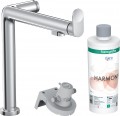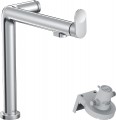Tap type
The tap type is indicated by the type of controls installed in it. A number of features of both management and application in general depend on this. Nowadays, on the market you can find
single cross handle,
two cross handle,
single lever (including those with additional
touch control),
non-contact and
thermostatic taps, as well as
push button models, which include both
self-closing and
thermostatic with a button. Here are the main features of these options:
— Single handle. Taps controlled by a single rotary handle (or a lever that moves in only one plane). In fact, they are not even "taps" as such, since they cannot mix hot and cold water and only regulate the pressure of the water supplied to them. It makes sense to use single handle models where the water temperature is constant and/or it makes no sense to regulate it — for example, in models for a kitchen filter (see "Suitable for"), for a washbasin where only cold water is used, or for an English-style washbasin, where hot and cold water is supplied from separate taps and mixed in the sink.
— Double handle. The classic design of taps, which does not lose popularity nowadays: two rotary handles responsible for
...hot and cold water, respectively. This design is simple and inexpensive, while being reliable, moreover, it is convenient for precise temperature control. In addition, two handle taps are not afraid of the difference in the pressure of hot and cold water, and therefore it is recommended to use them with boilers. The disadvantage of this option is the impossibility of changing the pressure separately from the temperature and vice versa — any change requires turning both valves, while the pressure and temperature can fluctuate.
— Single lever. Taps where the flow of water is controlled by a single lever. Most often, turning the joystick from side to side in such models regulates the temperature, and tilting relative to the axis of rotation controls the pressure. This allows you to adjust the temperature without changing the pressure (and vice versa) and even “remember” the selected temperature option (just lower the lever to close without turning it sideways). At the same time, such devices are less accurate in adjustment than double cross handle ones.
Occasionally, you can also find a more specific variety — single-lever taps, supplemented by a separate temperature control lever (see below). In such models, the main joystick controls only the pressure.
— Push button. Models of mixers in which the control of turning the water supply on and off is assigned to a button. The first press turns on the water flow, the second turns it off. The button can be either an auxiliary means for conveniently turning on/off the water, or the main control element for the tap. In the latter option, to adjust the water supply pressure, the button is often made rotary.
— Self-closing. A variety of taps with button activation. However, here the button works on the principle of a timer: when you press it, water flows, and then a special mechanism gradually returns the button back, blocking the flow. Closing time is selected in such a way that one press allows you to more or less effectively wash your hands. Such devices are especially popular in public places, such as toilets of cafés, shopping centres, cinemas, etc.: there is no need to worry that an inattentive visitor will forget to turn off the tap. Most often, these taps are single-temperature, but there are also models with a temperature adjustment lever (see below).
— Thermostatic. Taps that have a thermostat function — that is, capable of automatically maintaining the temperature set by the user. Such models are extremely convenient: when the pressure or temperature of the water in the pipes fluctuates, you do not need to fiddle with the settings — the device will independently select the operating mode so that the outlet temperature does not change (or at least these changes are minimal). The main disadvantage of thermostatic models is the complexity of the design and, as a result, the high cost. In addition, many of them require an electrical connection. For control, models may include rotary controls or a button (see above).
— Non-contact. Models operated in a non-contact way — without the need to touch the device. This format of operation is most popular in washbasin taps (see "Suitable for"): in such models, a sensor is used that reacts to the presence of the user's hands under the spout. This is especially convenient in common areas where it is undesirable to touch the tap once again. There are other types of non-contact models — in particular, devices for the kitchen or shower. In the first case, it can be inconvenient to open an ordinary tap with dirty hands after kitchen work. At the same time, the control may not be completely contactless — there are devices with valves or other equipment for pre-setting the temperature, while the sensor in them works only as a water flow switch. And touchless shower taps necessarily have an additional control for setting the temperature; the sensor in them reacts not just to the hands, but to the whole person.
— Single-lever + touch. A variety of single-lever mixers (see above), equipped with an additional switch. As in conventional single-lever models, the joystick in such devices is used to adjust the pressure and temperature; the difference lies in the fact that the water is opened not by a lever, but by the mentioned switch. In other words, it is enough to set the optimal pressure and temperature once using the joystick — and then you can turn on the water by simply touching the switch. The device of the switch itself can be different: in some models, the entire tap's body plays its role, in others a special button or even a foot pedal is provided. The exception is the non-contact models described above — they may be similar in design and method of use, but all the same, these taps are classified into a separate category.Water flow
The maximum water flow during the operation of the tap, in other words, the maximum amount of water that it can pass through in a minute. This characteristic is important, foremost, for models designed for baths (see "Suitable for"): the greater the throughput, the faster the bath will fill. However, the meaning of this paragraph is not limited to this. First, flow information can be useful in certain calculations related to water supply — for example, to calculate the required pump capacity. Secondly, high-end taps can be equipped with aerators to achieve a powerful and efficient jet with low water consumption; the consumption indicated in the characteristics allows you to evaluate the efficiency of such devices in comparison with analogues.

